Voodoo Envy M:860 – Gaming Notebook Review
Voodoo Envy M:860 – Gaming Notebook
The Voodoo Envy M:860 is a stunning gaming notebook, but you're going to need very deep pockets if you want one.
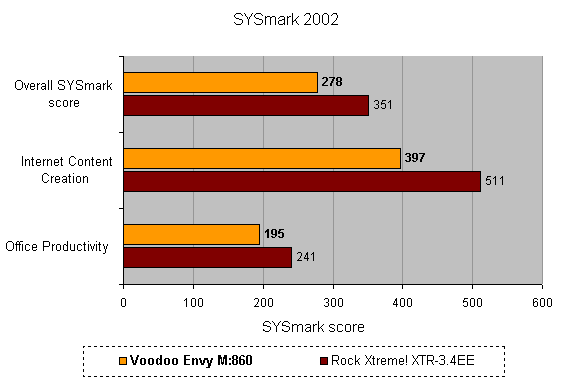
Verdict
Key Specifications
- Review Price: £2479.00
Last week I looked at the Rock Xtreme! XTR-3.4EE gaming notebook and this week the mobile gaming theme continues with this – the Voodoo Envy M:860. Voodoo has been making high-end gaming notebooks for some time, and has built its reputation on producing cutting edge and individually styled machines, and this particular model is no different.
The Rock did it’s best to make the Xtreme! look different and attractive, but when you look at the Voodoo you realise that Rock still has some way to go in terms of aesthetics. To say that this Voodoo looks special is an understatement of epic proportions. Even though it’s finished in a slightly subdued white, the lacquered surface just makes it gleam when you take it out of your bag and the traditional Voodoo Tattoo on the lid is far more imposing than it was on the red Envy M:855 that we looked at a little while ago. The left and right sides of the chassis are finished in lacquered black, and the overall effect in conjunction with the white is stunning.
So, there’s no denying that Voodoo knows how to build a good looking machine, and of course you can specify the colour yourself, as well as the design of the tattoo the lid, although it’s worth bearing in mind that the latter carries with it an extra cost. I have to say that when I asked for this notebook from Voodoo I quite fancied the orange colour, but then I was told it would be shipping in blue, which was my second choice. However, I would never have chosen white, but now that I’ve seen it, I’m a complete convert.
It’s no surprise to see that the Envy M:860 is a pretty high-spec notebook. After all, if you want to play the latest games on the move, you’re going to need a bit of grunt under the hood. Unlike the Rock last week, this Voodoo is based on AMD technology and the central processing duties are fulfilled by an Athlon 64 3400+. Supporting the AMD CPU is 1GB of 333MHz DDR RAM and a 60GB 7,200rpm hard disk – both these components should help to push the performance of the Voodoo that bit further.
Of course you can’t have a gaming notebook without a decent graphics solution, and Voodoo has gone for the best mobile graphics chipset available in the shape of the ATI Mobility Radeon 9700 complete with 128MB of memory.
Regardless of the fact that Voodoo designs its machines as mobile gaming platforms, the notebook basics are still very important – screen, keyboard and pointing device. Now, the Rock I looked at last week had a stunning screen thanks to the X-Glass finish, which made the image look particularly bright and the colours vivid. But the screen on this Voodoo is superb for different reasons. For a start this is a 15.4in widescreen display, so when you play DVD movies on the Voodoo you can watch them in their true anamorphic glory. That said, widescreen displays are pretty common on larger notebooks these days, but what isn’t so common is the 1,680 x 1,050 resolution. This is a fantastic notebook resolution and one that I haven’t seen on a machine since I reviewed the HP nx7000 last October. With this resolution you can easily use the Voodoo as your only computer since it lends itself perfectly to office applications, and having multiple windows open simultaneously is not a problem. Of course you’re not going to be able to take advantage of this amazing native resolution when playing games, since there’s no way that the Mobility Radeon 9700 could cope with it.
The keyboard isn’t quite as impressive as the screen, but it’s not a bad example. The keys are a decent size and most of the important keys have been given special attention. Both Shift keys, the Backspace key and the Tab key are large, but although the Return key is extended, it’s not quite the size I would have liked it to be. Also, the Spacebar is very small considering the size of this notebook, although to be fair I didn’t once find myself missing it. The cursor keys are set away from the rest of the keyboard, making it easy to use them, and just below them is a sticker stating “Powerful Personal Computer” in case you hadn’t already guessed. While typing, the keyboard does feel a little light and it does rattle a bit when typing at speed, but it’s not what I’d describe as a bad example. Finally, I had to get used to typing on a US spec keyboard, which has a slightly different layout to a British keyboard, but that’s something you’re going to have to accept if you order a machine from Canada.
Finally there’s the pointing device, and here Voodoo has gone for a touchpad rather than a trackpoint. Even though I prefer trackpoints to touchpads, this is a very good example of the breed and again reminds me of the HP nx7000 that I reviewed last year. Like the one on the HP, this touchpad has a scrolling section on the right hand side which allows you to scroll through web pages and documents without the use of buttons. The two selector buttons under the touchpad have a good tactile feel to them and click solidly in use.
Above the keyboard is an array of buttons which include shortcuts to Media Player, your email client, your web browser and the Windows search function. The power button is also located here as well as volume controls.
On the right side of the chassis you’ll find a DVD writer. Now although the DVD writer only has a DVD+RW logo on it, it is a dual format drive and will happily write to DVD-R/RW media as well. On the left there’s a single Type II PC Card slot, an SD Card slot, a CompactFlash slot, a four-pin FireWire port and two USB 2.0 ports. Finally at the rear you get an S-Video port, a D-SUB connector, a modem socket, an Ethernet port, headphone and mic connectors and the power socket. I have to say that I would have preferred to see the headphone and mic sockets at the front of the chassis for ease of access. If you want to connect the Voodoo without the use of wires, there’s also a built-in 802.11g WiFi adapter.
The AMD Athlon 64 3400+ is a very fast chip, although strangely, the performance results for the Envy M:860 weren’t as high as expected. The same situation was evident with the Fujitsu-Siemens Amilo A1630 reviewed last week. The SYSmark 2002 score of 278 is actually slower than the last Voodoo notebook we had in the labs, and that model was only running an Athlon 64 3200+ CPU. That said, the PCMark scores are a lot higher on the Envy M:860 than on the previous Voodoo. The 3D tests were good, but not as good as the Rock Xtreme! tested last week. But there’s no doubt that this Voodoo makes a good mobile gaming station. I quite happily played Far Cry and Unreal Tournament 2004 on it for a while and as with the Rock, I soon forgot that I was playing on a notebook as I became engrossed in the game. Basically, playing any game at 1,024 x 768 will result in a decent enough frame rate for smooth play.
The sound is also pretty good out of the built-in speakers. It’s obviously not ground shaking, but it’s more than acceptable for the odd bit of gaming if you don’t have any external speakers or headphones handy. The speakers can be turned up pretty loud without any hint of distortion, so try to be considerate if you’re enjoying a frag-fest while on a train.
What is really impressive is that no matter what the Voodoo is doing, it remains cool, whereas the Rock Xtreme! had a steady flow of warm air exiting the side of the chassis.
Where this Voodoo does beat the Rock Xtreme! hands down is with battery life. Despite the high-spec components, the Envy M:860 managed a battery life time of two hours 21 minutes, so you could actually play games on the move, which isn’t really an option with the Rock. But to be fair, the Rock’s lack of battery life is offset by its phenomenal performance scores – it’s a case of, you pay your money and make your choice.
Talking of money, you’re going to need pretty deep pockets if you want a custom-built machine from Voodoo. In the configuration I’m testing here, the Envy M:860 will set you back a not insignificant £2,206.56, but that’s before you add import duty to the bill, which, in the case of this machine came to £272.42. So you’re looking at a total price of £2,478.98 which is actually more expensive than the Rock Xtreme!, despite the latter’s ludicrously expensive P4 Extreme Edition CPU.
So, the Voodoo Envy M:860 is more expensive than the Rock Xtreme! and not as powerful, but if I was going to put some money down on a notebook that could handle the latest games it would be this one. Why? Well, because for me the high-resolution screen, beautiful finish and usable battery life outweigh the higher performance and slight difference in price. It’s true that this isn’t the fastest gaming notebook you can buy, that honour definitely belongs to Rock, but in terms of overall package I have to say that the Voodoo has the edge.
”’Verdict”’
The Envy M:860 is a beautiful notebook with a welcome flair of individuality. The high-resolution widescreen display is stunning and the gaming performance is solid. Unfortunately the CPU just didn’t seem to be performing at it’s optimum speed, but we did see this behavior in another Athlon 64 3400+ based machine. But the slightly under par performance and even the very high price can’t hide the fact that Voodoo knows how to build very special notebooks.
(table:features)

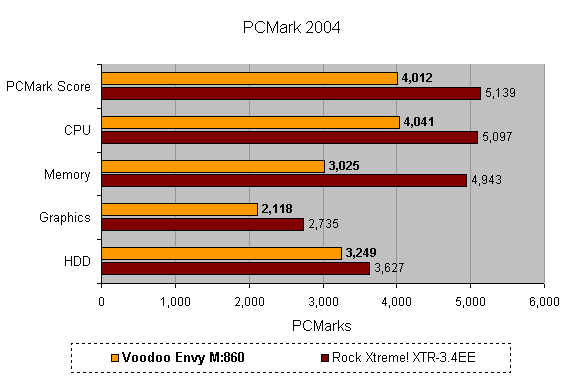
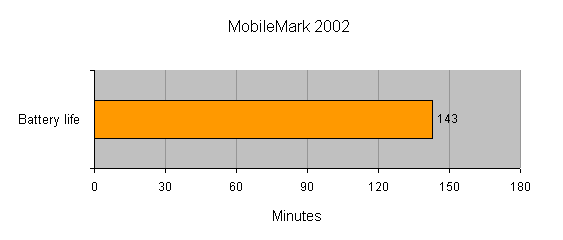
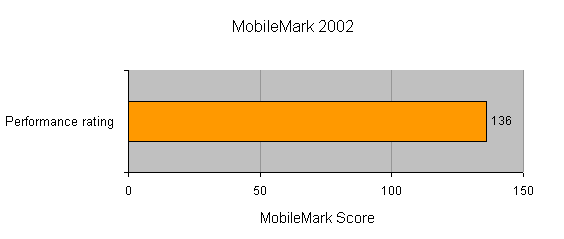
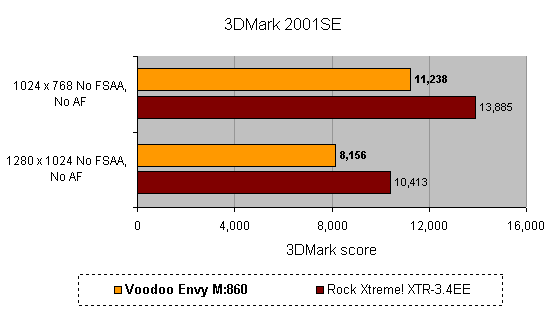
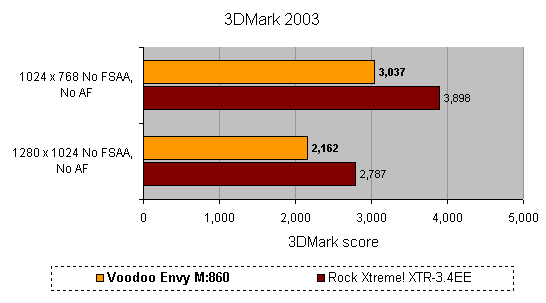
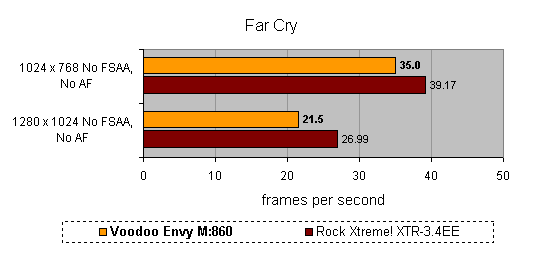
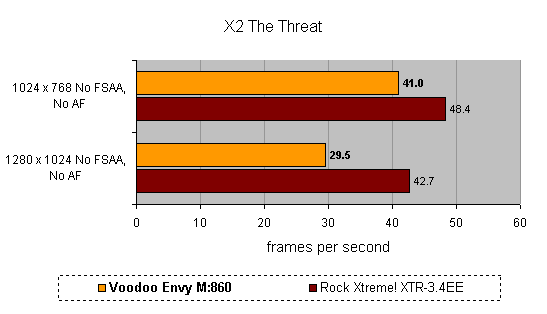
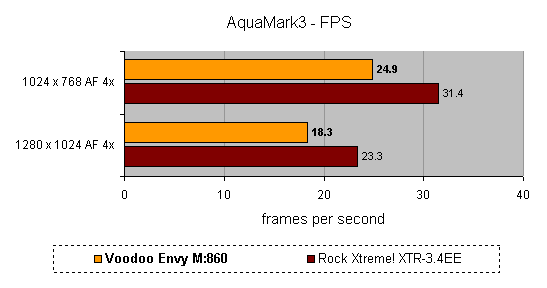
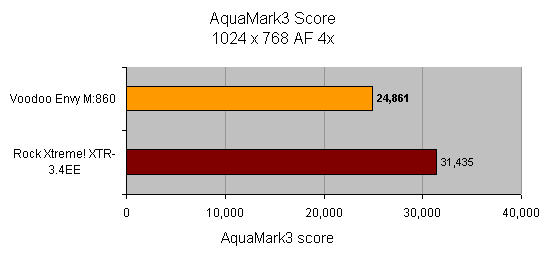
How we test laptops
Unlike other sites, we test every laptop we review thoroughly over an extended period of time. We use industry standard tests to compare features properly. We’ll always tell you what we find. We never, ever, accept money to review a product.
Trusted Score
Score in detail
-
Performance 9
-
Value 6
-
Features 10

